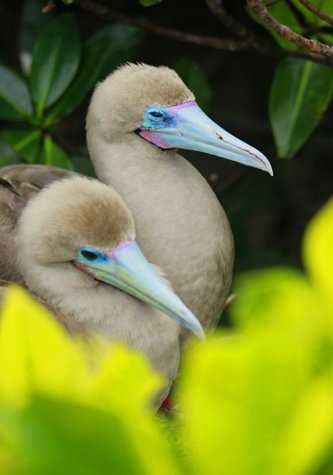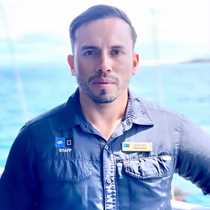Our expedition headed all the way north, where the National Geographic Islander anchored right in the middle of an old caldera from an extinct volcano that created the island of Genovesa.
We started our day going on a pre-breakfast kayaking outing along the titanic cliffs of Darwin Bay. Kayaking with hundreds of birds flying around us was quite an experience! About half a million birds are found on this island, and around 200,000 of them are red-footed boobies.
During our morning visit, we went to Darwin Bay. This site along a coralline beach offers an easy walk and fantastic views of a nesting colony of great frigatebirds, swallow-tailed gulls and red-footed boobies – the highlight of the morning. There are few places on the planet that offer such close encounters with these amazing seabirds. As we watched male frigatebirds display their red balloon pouches while desperately courting females, we marveled at how some species developed such fascinating breeding strategies. Red-footed boobies were just starting their nesting season and we repeatedly saw them bringing branches back to their nests.
It was a fantastic walk followed by deepwater snorkeling along the cliffs of Darwin Bay, where our guests spotted new species of fish and Galapagos fur seals (really sea lions) swam around us!
In the afternoon we headed to a different visitor’s site called Prince Philip's Steps, after the Duke of Edinburgh. Here, the trail took us through an incense tree forest. Passing boobies and frigates nesting along the way, we soon encountered a couple of short-eared owls (male and female) resting in the vertical fissures of the island. After walking further inland, we came across a storm petrel colony located near some large rust-colored lava fields. We were looking for more short-eared owls, a fascinating bird that on Genovesa occupies the ecological niche of top predator. Because the Galapagos hawk never colonized Genovesa, these owls are diurnal predators on this island. We were lucky enough to encounter three owls, the first two quite close to us.
This was an incredible expedition. We have learned so much on land and under water. Galapagos is a magical place that cannot truly be described in words.







